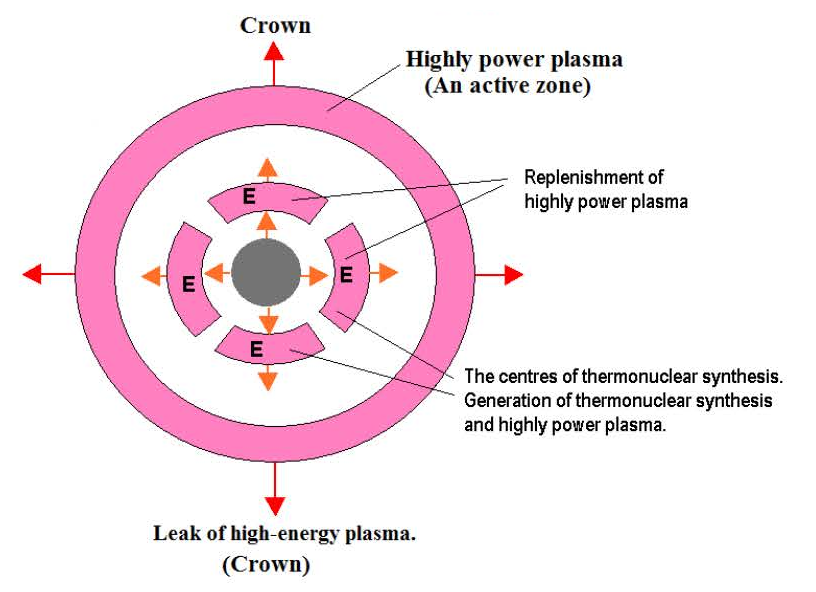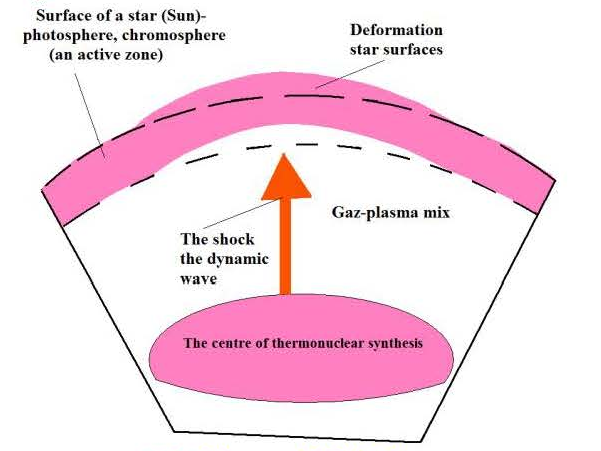At the decrease in concentration percentage of the energetically high capacious «fuel», energetically high capacious thermonuclear synthesis in the star fades away. The receipt of highly power plasma in «the active zone» decreases, the star passes into the «red giant» state.
Let’s consider the dynamics of thermonuclear synthesis process in «the active zone».
In the top layers of «the active zone», in the chromospheres through a crown there is an outflow of a matter in the form of star wind radiation in a space. Hence, the outflow of the matter participating in the thermonuclear synthesis reduces the energy activity and the capacity of «the active zone». The decrease in energy capacity of «the active zone» conducts to the destruction of the star, since the high-energy plasma of «the active zone» keeps the gas-plasma mix inside of the star. Decrease in sizes and capacities of «the active zone» conducts to an outflow of the gas-plasma mix into the open space. Hence, the generation and delivery of high-energy plasma to the active zone are necessary for star existence. That makes the generation of thermonuclear synthesis necessary. The generation of thermonuclear synthesis in the gas-plasma mix occurs under the action of dynamic processes in the star and in «the active zone». The thermonuclear synthesis center is rising in the photosphere, under the action of Archimedes force, increasing the quantity of high-energy plasma in «the active zone». That means that the outflow of high-energy plasma from the chromospheres, through the crown into the open space, is compensated by updating the photosphere with high energy plasma, which is participating in the thermonuclear synthesis of the gas-plasma mix. As we already stated, the existence of high energy plasma in «the active zone» of stars is a necessary condition for its existence. The thermonuclear synthesis is the generator for perceiving high-energy plasma from the gas-plasma mix. The generation and self-regulation of the thermonuclear synthesis is a vital process for a star.
The speed of thermonuclear synthesis generation depends on sizes, weight and age of the star, and on the concentration of the energetically high capacious «fuel» in the gas-plasma mix of a star.
It is probable, that there are minimal and maximal, high-speed limits for thermonuclear synthesis generation in the star for each weight. In the beginning of life, the speed of thermonuclear synthesis generation is maximal, and in the end of life it is minimal. When the decrease of thermonuclear synthesis generation speed reaches below the minimal value, the star transfers to red giant stage. Probably, for the birth of stars, there are high-speed limits of thermonuclear synthesis generation, depending on their sizes and weights.
For stars of greater weights, on excess of the maximal speed of thermonuclear synthesis generation conducts to the break of the collected gas weight in on «accretion disk» on few stars.
For stars of small weights during the moment of thermonuclear synthesis generation, below the minimal speed — on star will not light up completely.
Shock waves
The thermonuclear synthesis with energy allocation, being processed in the top layers of the star’s atmosphere, and as well in the star itself, creates shock dynamic waves in the gas-plasma mix.
How do the shock dynamic waves extend inside of the star and how do they influence the process of kernels synthesis?
It is impossible to give simple answers to these questions. We shall try to partially predict the movement of the shock dynamic waves in the star’s gas-plasma mix. The basic sources of the shock waves are the centers of thermonuclear reactions. The main source of the shock waves in a star is in the top layers of the gas-plasma mix — in the photosphere and the chromosphere. The shock waves from sources (points A, B, C) in «the active zone», figure № R-6.3, are moving to the center of the star.

(93) Figure № R-6.3
On the way they follow, the shock waves are imposed on each other, increasing or reducing their force. Coming nearer to the star’s center, their force is focused to the center’s direction. Moving in the gas-plasma mix, the shock waves also encounter movement resistance from the gas-plasma mix. Having reached the center of the star, the shock waves should be focused, amplify and reflected from encountering each other or from the surface of the star’s kernel. The shock waves switch the movement direction to the opposite. If in the center of the star there is a firm kernel, the substance on the surface of this kernel, after the impact of a wave should be condensed, and the shock wave supposed to be reflected from the surface to the reverse side. At the movement to the reverse side, the reflected shock wave should collide with the following shock wave going from «the active zone» to the center. At the moment of meeting, the concentration and focusing of shock waves with each other and as they collide with obstacles, or the star’s kernel, there is a high probability of occurrence of thermonuclear synthesis centers, figure № R-6.4.
(94) Figure № R-6.4
The new thermonuclear synthesis centers, inside of the star, create shock waves which, extend in the gas-plasma mix and bring the contribution to the general distribution scheme of shock waves to the gas-plasma mix of a star.
The birth of the thermonuclear synthesis centers in the gas-plasma mix influences the surface of the star as well. Thermonuclear explosion of big capacity in the gas-plasma mix creates a powerful shock wave. When it reaches the environment of a star — «the active zone», it deforms it, temporarily, figure № R-6.5.
(95) Figure № R-6.5
This phenomenon is visible well in the documentary film of NASA. The shock wave («tsunami») moves on the Sun’s surface from the source of explosion located inside of the star.
Inside of the star occur nuclear explosions. The reasons for these explosions can possibly be thermonuclear reactions of the synthesis of easy kernels, a spontaneous disintegration and division by neutrons of heavy kernels.



